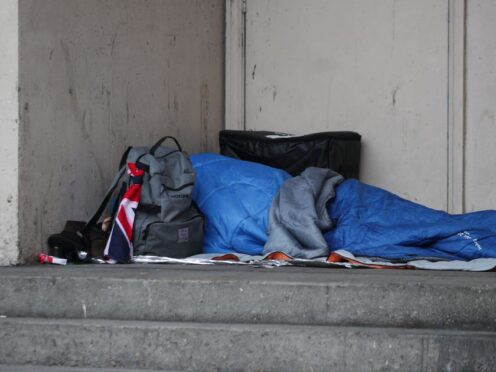Hundreds of refugees faced the prospect of being left exposed to life-threatening temperatures in London after being evicted from Home Office accommodation, figures suggest.
Information shared with the PA news agency shows 242 evicted refugees were among the 1,284 rough sleepers given emergency placements after London Mayor Sadiq Khan activated a new extreme weather protocol for the first time when a cold snap took hold on January 8.
The London Councils group, which represents 33 local authorities in the capital, found 311 refugees were forced to sleep rough across the month as a whole after being required to leave accommodation provided under the National Asylum Support Service (NASS) because their claims had been closed.
This number represents a significant uplift on the 93 refugees identified as being in the same position in September 2023, when London Councils began monitoring the numbers.
The January survey also found that more than 90% of refugees living on the streets had received a positive decision on their asylum claim, which could include being granted protection, resettlement or an alternative form of leave in the UK.

In total, 1,087 refugees asked London homelessness services for help in January following Home Office evictions, an increase of 78% since September 2023.
This total includes the so-called “hidden homeless” who sleep in various unregistered off-street settings.
Refugees are required to leave NASS accommodation within 28 days of their asylum claims having been processed.
But London boroughs argue this is insufficient time for individuals to find work and housing, particularly as many have experienced trauma and face language barriers, regularly leading to homelessness.
London Councils said it anticipates rough sleeping among refugees will continue to rise sharply as the Home Office speeds up asylum decisions and reduces its use of hotels.
Grace Williams, Labour leader of Waltham Forest Council and London Councils’ lead for asylum and refugees, described the spike in refugees rough sleeping as “deeply alarming”.
She added: “No-one wants to see refugees become homeless after leaving Home Office accommodation, but this is happening more and more due to serious flaws in the system and the Government’s approach to the issue.
“A longer move-on period for those leaving Home Office accommodation is crucial, as well as funding for the councils whose local services provide vital support and sanctuary for those in need.
“London is already grappling with a severe homelessness crisis. Rough sleeping among refugees puts extra pressure on already-stretched local services, but much more could be done to prevent it occurring in the first place. We are urging the Government to listen to boroughs’ concerns and work with us in tackling this challenge.”
The Government has previously set a target of ending rough seeping by 2024.
Its latest snapshot figures show 3,898 people were estimated to be sleeping rough on a single night in autumn 2023, an increase of 27% from 2022.
London figures reveal 1,132 people were estimated to be sleeping rough in the city on a single night in autumn 2023, a 32% increase from 2022.
Emma Haddad, chief executive of homelessness charity St Mungo’s, said: “It is both disturbing and ironic that by pushing people out of asylum accommodation onto the streets, the Government is undermining its own ambition of ending rough sleeping by 2024.
“It is causing homelessness that is completely preventable and our outreach teams are left trying to support increasing numbers of people in London who didn’t need to be on the streets in the first place.
“While the Government’s ambition to end use of hotels for asylum seekers is understood, there are more sensible ways of doing so – in partnership with those of us on the ground – that would save money and avoid human misery in the process.”
Among a range of proposals to prevent refugees becoming homeless, London Councils has called on the Government to extend the notice period for refugees leaving Home Office accommodation to 56 days to allow local authorities more time to assist with housing arrangements.
The group also said the eligibility for Local Authority Housing Fund properties should be broadened to include newly recognised refugees alongside those from Ukraine and Afghanistan.
A Home Office spokesperson said: “Once a newly recognised refugee is issued a biometric residence permit, they get 28 days to move on from asylum accommodation.
“Support is also available through Migrant Help and their partners, which includes advice on how to access universal credit, the labour market and where to get assistance with housing.
“We are working with local authorities to manage the impact as we reduce the number of asylum-seekers awaiting a decision.”
